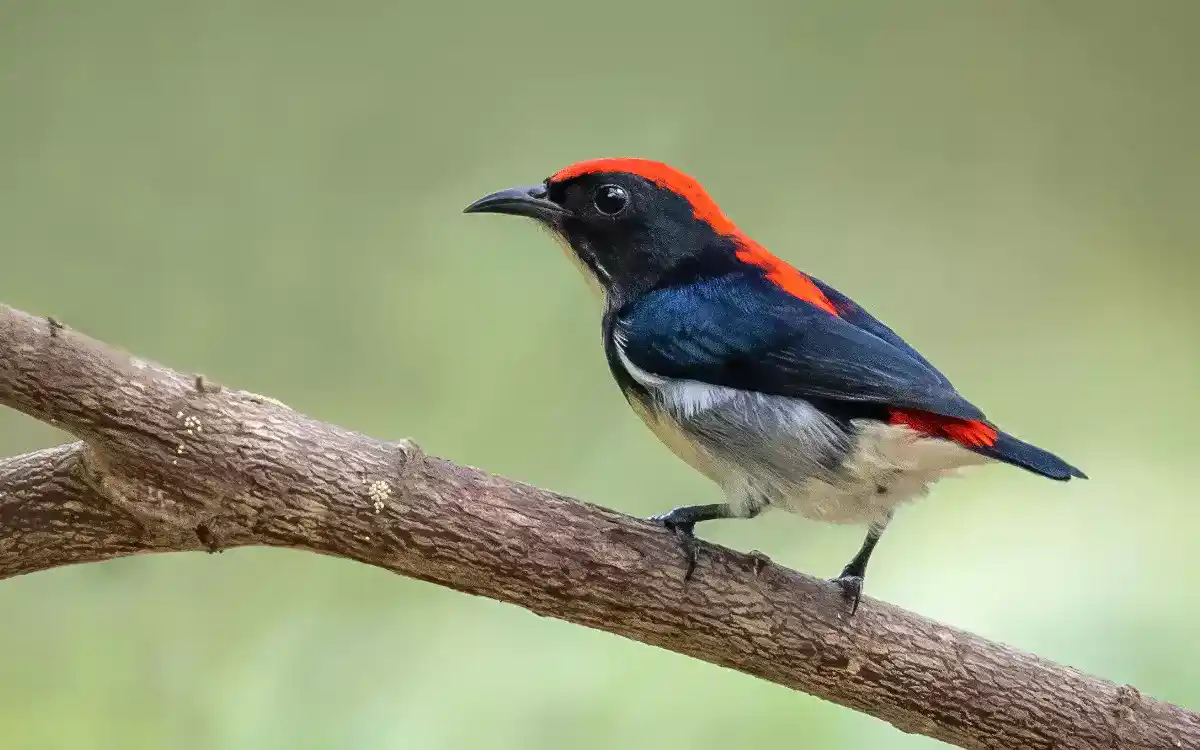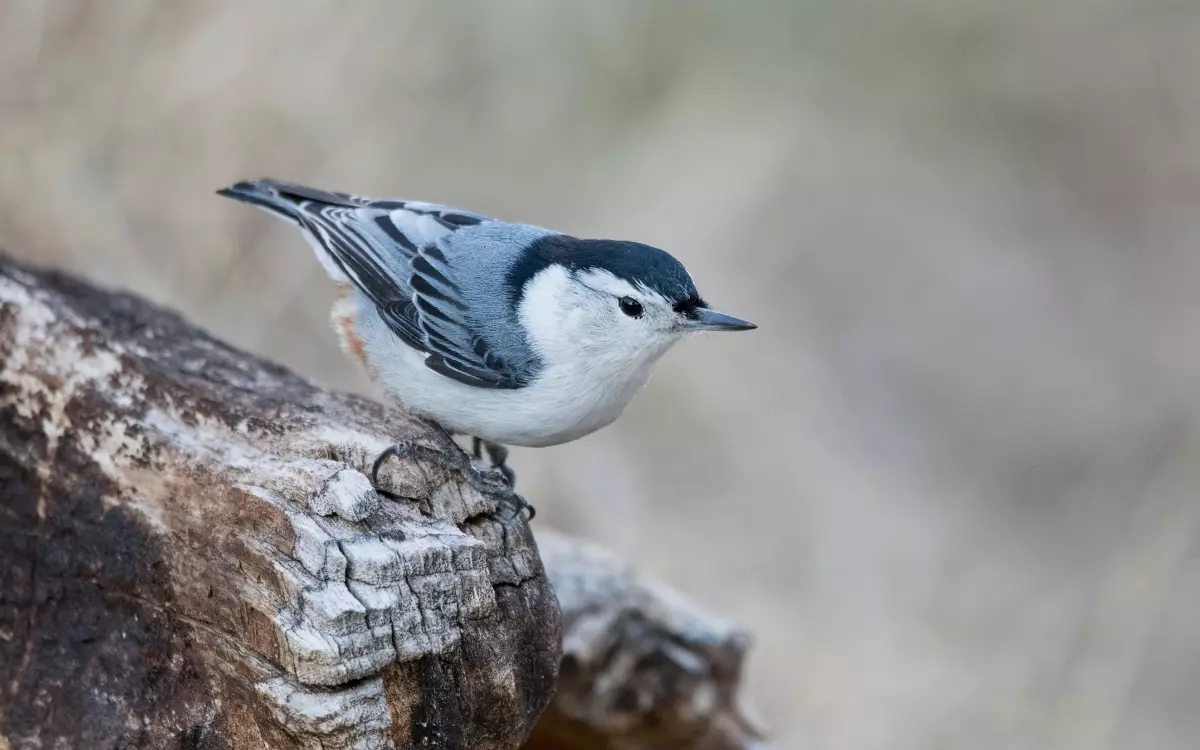9 Bird Builds the Best Nest: Explore Architecture
Birds build nests to keep their eggs and babies, called chicks, safe. But not all nests are the same. Some birds make big, strong nests, while others build small, cozy ones. In this article, we’ll find out which bird builds the best nest.
Factors Determining the “Best” Nest:
When we talk about which bird builds the best nest, there are several factors to consider. Let’s discuss three main factors: size and durability, protection, and suitability for rearing chicks.
Size and Durability
A good nest needs to be the right size for the bird and its chicks. It should also be durable, meaning it should last for a long time without breaking. Some birds build large nests that can hold many chicks, while others build smaller nests for just a few chicks.
The materials used, like sticks, leaves, or mud, also play a part in how strong and durable a nest is. For example, Bald Eagles build massive nests with large sticks that can last for many years.
Protection from Predators and Weather Elements
A nest should provide protection from dangers like other animals who might want to harm the eggs or chicks. It should also shield the birds from bad weather such as rain, wind, or extreme heat. Birds like the Malleefowl build nests on the ground, covering them with sand to keep the eggs warm and hidden from predators.
Suitability for Rearing Chicks
Lastly, the nest should be suitable for rearing chicks. This means it should be a safe and comfortable place for the chicks to grow until they are ready to leave the nest. The design of the nest and the materials used can help keep the chicks safe and comfy. For instance, birds like Orioles build hanging nests that sway in the wind, making it hard for predators to reach them.
10 Bird Builds the Best Nest:
1. Sociable Weaver: A Master Builder in the Bird Kingdom
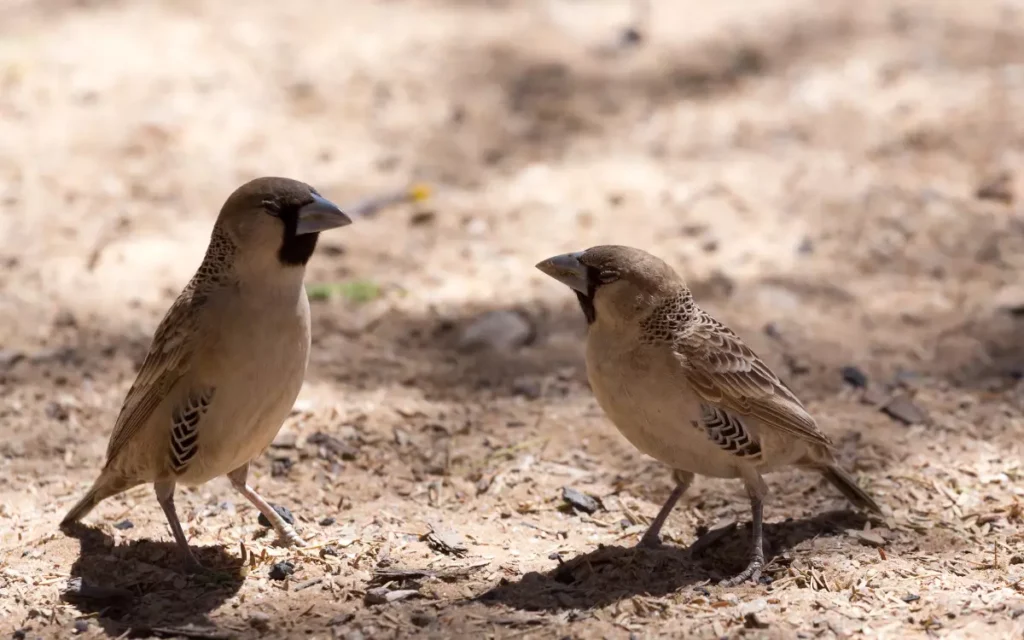
The Sociable Weaver is a small bird with big ideas, especially when it comes to building nests. They are known for creating some of the largest and most impressive nests in the bird kingdom. These nests are not just big; they are a marvel of birdy engineering that provides a home for many families at once.
Nest Size:
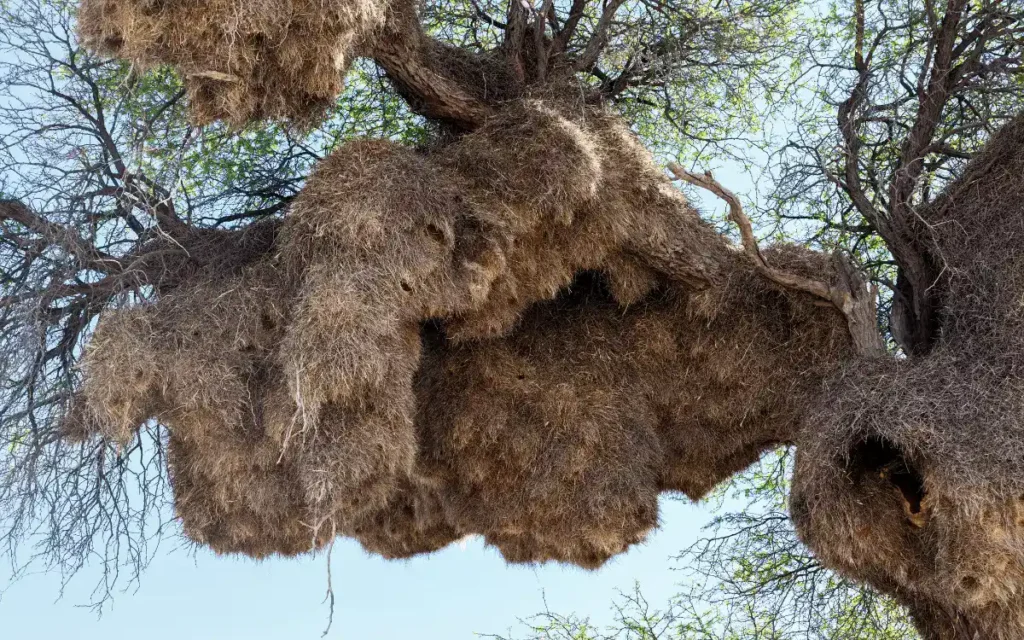
The nests built by Sociable Weavers are enormous! They can be as 7 meters (23 feet) in diameter and house over a hundred birds. Imagine a giant haystack hanging from a tree; that’s what a Sociable Weaver’s nest looks like. It’s like a big apartment complex in the sky where each bird family has its own private chamber.
Durability:
Sociable Weaver nests are also very durable. They are built to last. Some nests have been known to last for several decades. The birds use sturdy materials like sticks and grass to make sure the nest stays together. The outer layers are tightly woven to withstand the harsh weather conditions of the desert areas where they live.
Functionality:
The functionality of these nests is amazing. Inside the big nest, there are many small chambers, each one home to a different bird family. This design not only provides shelter but also creates a sense of community among the birds. During the cold nights, the birds huddle together to stay warm, and during the hot days, the nest provides shade and keeps them cool.
The Sociable Weaver nest is like a bustling bird city, full of life and chatter. It’s a fine example of how teamwork and smart design can create a safe and comfortable home for everyone. Through their extraordinary nest-building skills, Sociable Weavers teach us a lesson about community living and the power of working together.
2.Barn Swallows: Crafting Cozy Homes

Barn Swallows are small, agile birds known for their swift flying and their knack for building cozy, cup-shaped nests. Unlike some other birds, Barn Swallows prefer to stay close to humans and often build their nests on man-made structures.
Nest Size:
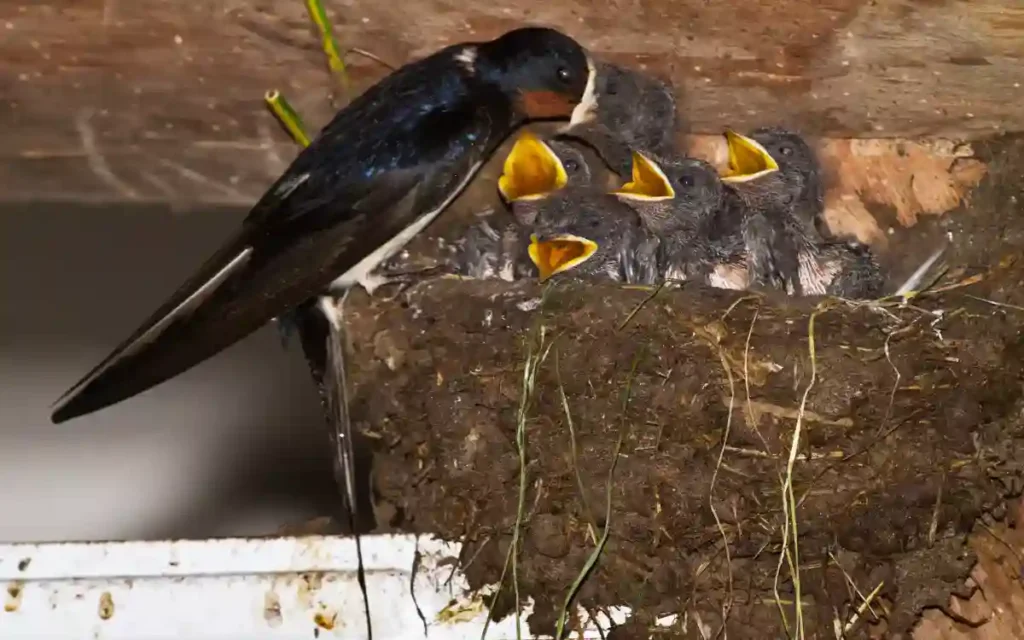
The nests of Barn Swallows are relatively small but perfectly shaped to fit the bird and its chicks. The cup-shaped nest is 3 inches (7.6 centimeters) across at the rim and 2 inches (5.1 centimeters) deep enough to hold the eggs and keep the young ones safe until they are ready to fly on their own.
Durability:
When it comes to durability, Barn Swallows build their nests to last through the breeding season. They use a mix of mud and straw, making the nests sturdy and strong. The mud dries to become hard, forming a solid shell that sticks well to the structure it’s built on, whether it’s a ledge, a beam, or the eaves of a building.
Functionality:
The functionality of these nests is simple yet effective. The cup shape provides a secure place for the eggs and chicks, preventing them from falling out. It also shields them from predators and bad weather. The location of the nest, often under the eaves of buildings or on ledges, provides additional protection and keeps the inside of the nest dry during rain.
Barn Swallows are experts at finding the best spots to place their nests to ensure the safety and comfort of their young ones. Their nests may be small, but they are crafted with care and precision, showing the remarkable ability of these birds to create a safe and nurturing environment for their families.
3.European Penduline: The Hanging Home Architect
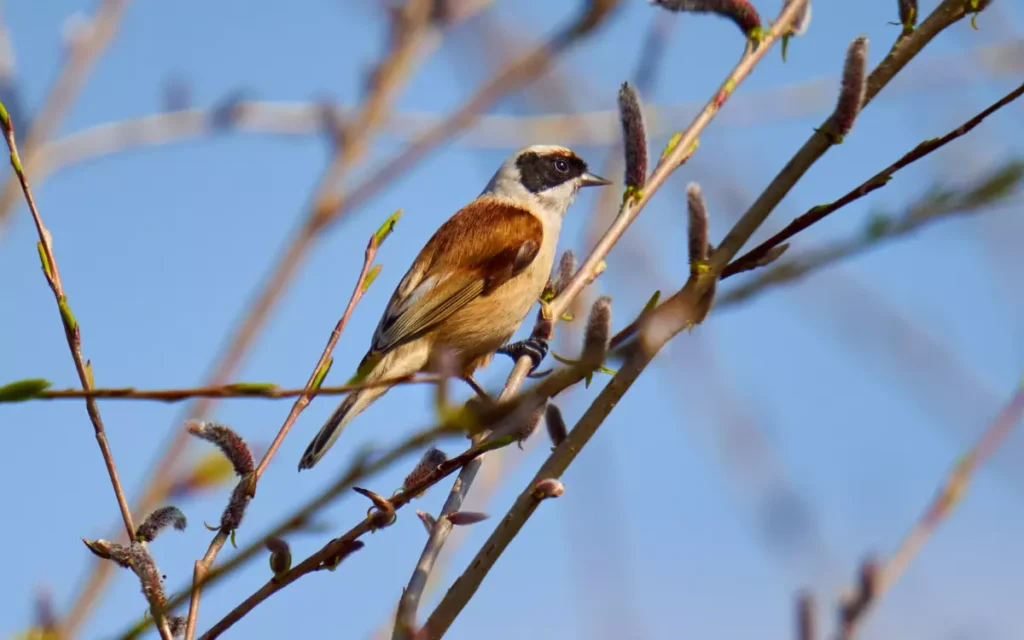
The European Penduline is a tiny bird with a big talent for building. They create one of the most beautiful and intricate nests among birds. Their nests are not just pretty to look at but are also smartly designed to protect their young ones.
Nest Size:

The nests built by European Pendulines are 25 cm (9.8 in) in height and 17 cm (6.7 in) in diameter but wonderfully crafted. They resemble little hanging pouches or bags suspended from the ends of tree branches. Even though the nests are small, they provide just enough room for the eggs and the chicks to stay comfy and safe.
Durability:
When it comes to durability, the nests of European Pendulines are quite strong. They use a variety of materials like twigs, leaves, and even spider silk to weave their nests. The spider silk helps to keep the nest together and makes it stretchy, so it sways safely in the wind without tearing apart.
Functionality:
The functionality of these nests is also impressive. The hanging design of the nest makes it hard for predators to reach inside. The entrance to the nest is at the top, which is another smart way to keep dangers out. Inside, the nest is lined with soft materials like feathers, making it a warm and cozy home for the chicks.
Moreover, the place where they hang their nests, usually over water or marshy areas, adds an extra layer of protection against predators who find it difficult to reach the hanging nest.
The European Penduline shows a remarkable blend of beauty, strength, and smart design in its nest-building. Through their unique nests, these birds provide a snug and secure haven for their young, showcasing the amazing variety and creativity found in nature.
4.Hummingbirds: Tiny Builders of Cozy Nests
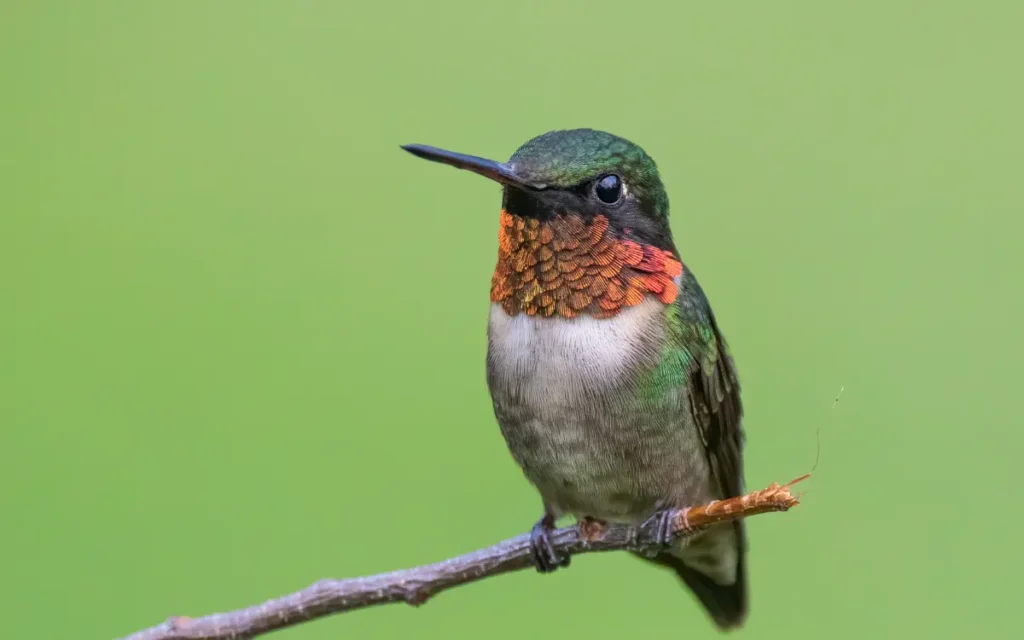
Hummingbirds are among the smallest birds on the planet, but when it comes to building nests, they have big hearts. Despite their tiny size, they create cozy and sturdy nests to keep their eggs and babies safe.
Nest Size:
Hummingbird nests are tiny, just like the birds themselves. They build nests that are about 1.5 inches (3.8 centimeters) from a half-dollar coin. Even though the nests are small, they are perfectly shaped to hold the eggs and keep the young ones secure.
Durability:
Durability is a key feature of hummingbird nests. They use plant down, spider silk, and other soft materials to weave their nests. The spider silk makes the nest stretchy, so as the baby birds grow, the nest expands to accommodate them. This smart choice of materials makes the nest both strong and flexible.
Functionality:
The functionality of hummingbird nests is remarkable. The nest’s location is usually on a thin branch which makes it difficult for predators to reach. The materials used in building the nest also provide good insulation, keeping the inside warm during cold nights and cool during hot days. The soft lining of the nest provides a comfy and snug environment for the eggs and chicks.
Moreover, the outer part of the nest often blends with the tree, camouflaging it from predators. This is a smart way to hide the nest in plain sight, making it a safe haven for the young ones.
Through their careful and detailed nest-building, hummingbirds ensure the safety and comfort of their offspring. They show us that no matter how big or small, every creature in nature has its unique way of creating a cozy home for their family.
5.Rufous Hornero: The Mud Home Maker
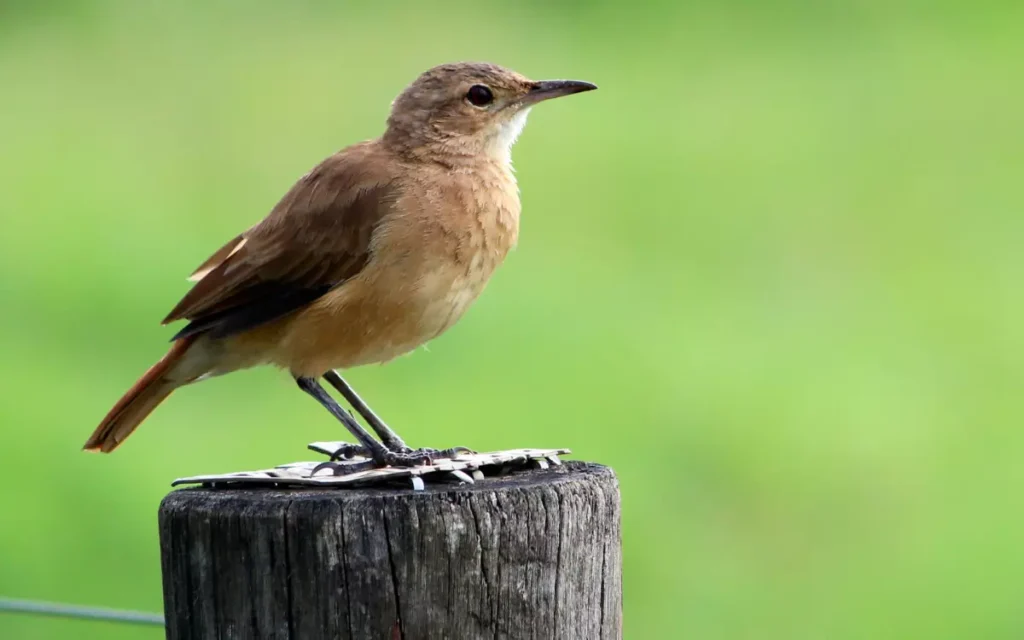
Rufous Horneros are remarkable birds known for their amazing ability to build sturdy and unique nests. Unlike many other birds, they use mud to craft their homes, earning them a nickname – the ovenbird.
Nest Size:

The nests built by Rufous Horneros are quite spacious. They craft dome-shaped nests that resemble old-fashioned clay ovens, which is why they’re often called ovenbirds. Inside the dome, there’s enough space for a nest 20 to 30 cm in diameter and 20 to 25 cm high for the bird parents and their chicks to live comfortably.
Durability:
When it comes to durability, the mud nests of Rufous Horneros are top-notch. Once the mud dries, it becomes hard and strong, providing a solid shelter for the birds. These nests can withstand the elements, keeping the birds safe from rain, wind, and even the hot sun. The hard exterior of the nest also makes it difficult for predators to break in, adding an extra layer of protection for the birds inside.
Functionality:
The functionality of these nests is quite impressive. The dome shape is not just unique but also practical. It helps in regulating the temperature inside, keeping it cool during the day and warm during the night. The entrance is small, which helps in keeping predators out while allowing the birds to go in and out easily.
Moreover, Rufous Horneros often build their nests on man-made structures like buildings or telephone poles, which keeps them elevated and away from ground-level dangers.
The Rufous Hornero showcases a brilliant blend of creativity and practicality in its nest-building. With just mud and their diligent effort, these birds create a safe, durable, and functional home that stands as a marvel of natural engineering.
6.Common Tailorbird: The Tiny Tailor of the Treetops
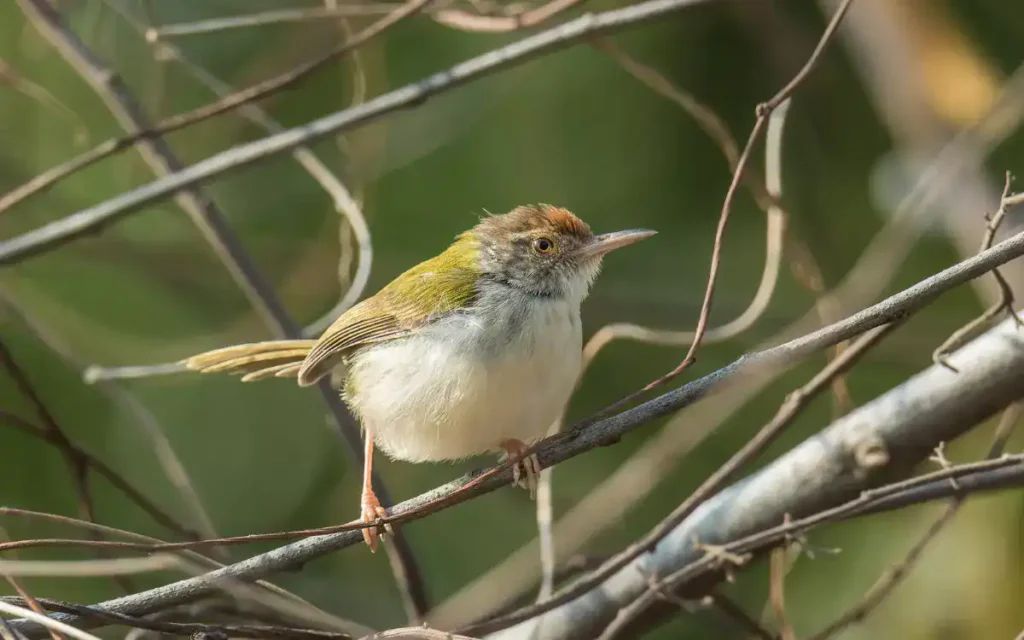
The Common Tailorbird is a small, active bird that carries a big title as a tailor. Unlike many other birds, the Common Tailorbird sews its nest together, just like a tailor sews clothes. This unique way of nest building makes this bird stand out in the avian world.
Nest Size:

The nests crafted by Common Tailorbirds are small, cozy, and well-hidden. They create a cradle-like nest that is carefully stitched between green leaves. Nest size 10 to 14 centimeters (3.9 to 5.5 inches) and weigh 6 to 10 grams (0.21 to 0.35 ounces). It’s like a tiny leafy room in the midst of the green foliage.
Durability:
Durability is one of the hallmarks of a Common Tailorbird’s nest. The bird uses its beak to pierce holes along the edges of leaves and then sews them together using plant fibers or spider silk. This sewing technique ensures that the nest stays securely attached to the branches, even during windy or stormy weather. The nest’s outer part is further strengthened with twigs and grass, making it a durable home for the young ones.
Functionality:
The functionality of these nests is outstanding. The sewn leaves provide a natural cover, camouflaging the nest and keeping it hidden from predators. The nesting location, usually chosen amidst dense foliage, adds another layer of protection, making it difficult for predators to spot the nest. Inside, the nest is lined with soft materials, offering a comfy and warm shelter for the eggs and chicks.
The Common Tailorbird demonstrates a unique blend of creativity, skill, and precision in its nest-building practices. Through its remarkable tailoring skills, it creates a safe, well-hidden, and snug home for its offspring, teaching us a lesson about the boundless ingenuity found in nature.
7.The Bowerbird: Architect of Nature’s Art Galleries

The Bowerbird is not just a nest-builder, but an artist too! Unlike most birds, Bowerbirds build special structures called bowers to attract mates. These bowers are not exactly nests, but they play a big part in the bird’s life.
Nest Size:

The size is 22 cm (8.7 in) and 70 g (2.5 oz) to 40 cm (16 in) and 230 g (8.1 oz), but it’s big in style. Bowerbirds create an avenue-like structure with an arch of sticks and then decorate the area with colorful objects they find, like feathers, shells, and even bits of plastic. It’s like a small art gallery displaying a collection of fascinating items.
Durability:
Durability is important to a bower, as it needs to stay intact to impress female bowerbirds. The males use strong sticks and carefully place them to form a sturdy structure. Even though it’s not meant to protect against weather or predators like a typical nest, a bower is built strong enough to last through the courting season.
Functionality:
The functionality of a bower is quite different from other bird nests. It’s not meant to shelter eggs or chicks but to attract a mate. The male Bowerbird spends a lot of time collecting colorful and shiny objects to decorate his bower, hoping to catch the eye of a female. The more attractive the bower, the higher the chances of finding a mate.
The Bowerbird’s architectural and decorating skills are a delightful display of creativity and the drive to find a mate. Through meticulous design and a keen eye for beauty, Bowerbirds create a unique space that showcases their ability to mix nature and artistry in their quest for love.
8. Ovenbird: The Ground Nesting Expert

The Ovenbird is a small yet crafty bird known for its ground-nesting habits. Unlike birds that build nests on trees or cliffs, Ovenbirds choose the forest floor to create their unique homes, which resemble little ovens.
Nest Size:

The nests built by Ovenbirds are 3 inches (7.6 centimeters) across and 2 inches (5.1 centimeters) deep, but they are cozy and well-designed. They create dome-shaped nests, which are about the size of a softball. The inside of the nest is roomy enough to hold the eggs and provide shelter for the chicks once they hatch.
Durability:
Durability is a key feature of Ovenbird nests. They use a mix of leaves, grass, and twigs to build a strong structure. The outer shell of the nest is covered with a layer of leaves which helps in keeping the inside dry even during rainy days. The domed shape adds strength to the nest, ensuring it stays intact and provides a secure home for the bird family.
Functionality:
The functionality of these nests is well thought out. By building their nests on the ground, Ovenbirds find a clever way to stay hidden from predators that might be looking for nests up in the trees. The dome shape with a side entrance makes it hard for predators to reach inside. Moreover, the camouflaged appearance of the nest blends well with the surroundings, making it a hidden haven on the forest floor.
The Ovenbird showcases a different take on nest-building by choosing a less common location and creating a nest that is both durable and functional. Their unique nesting habits reflect the adaptability and creativity found in the bird world, ensuring the safety and well-being of their young ones in a humble yet effective manner.
9.Southern Masked Weaver: The Vibrant Nest Weaver
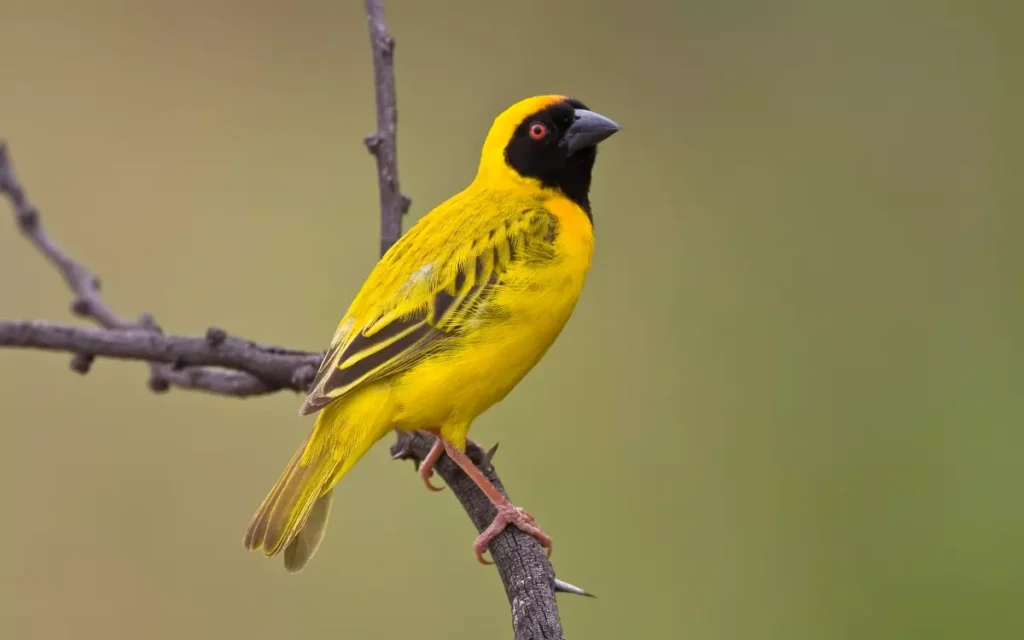
The Southern Masked Weaver is a lively bird with a special talent for weaving beautiful and secure nests. Known for their bright yellow color and black face mask, these birds are true architects of the avian world.
Nest Size:
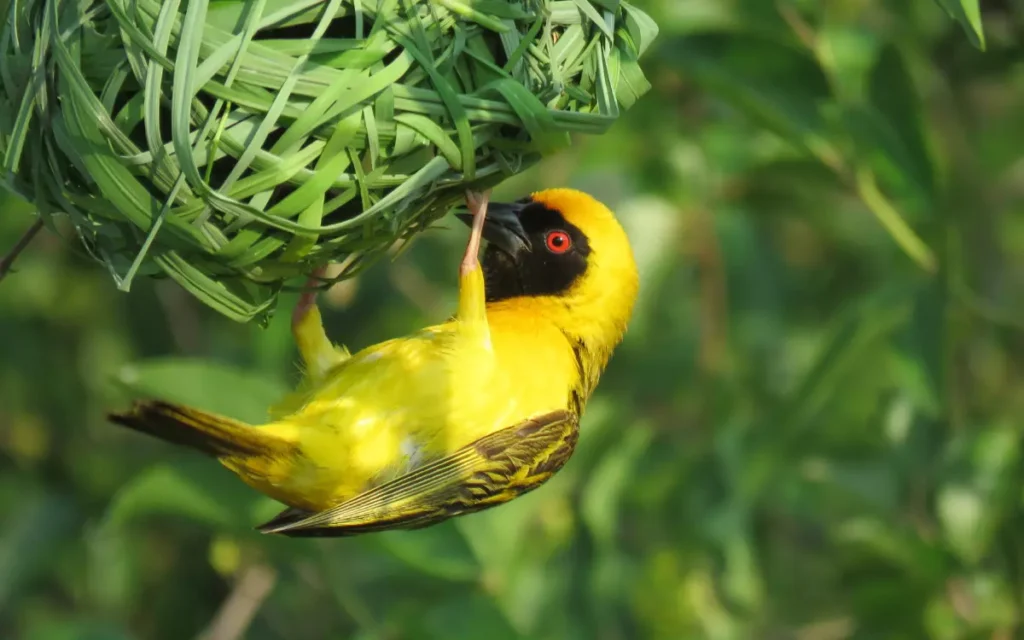
The nests built by Southern Masked Weavers are quite roomy considering the size of the bird. They weave intricate nests that hang down from tree branches like dangling baskets. Each nest size 20-25 cm in diameter is big enough to provide a safe and comfy home for the eggs and the young chicks.
Durability:
Durability is a strong feature of these woven nests. The Southern Masked Weaver selects strong, flexible grass stems and strips of leaves to construct its nest.
The weaving technique they use makes the nest sturdy and able to sway safely in the wind. The tight weave also offers protection from rain, keeping the inside dry and cozy for the chicks.
Functionality:
The functionality of the Southern Masked Weaver’s nest is quite impressive. The hanging design helps to keep predators away, making it difficult for them to access the nest. The entrance hole at the bottom of the nest is another smart feature; it’s an added hurdle for predators while allowing the birds easy access. Inside the nest, the soft lining of grass provides a warm and snug environment for the eggs and chicks.
Moreover, the location of the nests, often built over water or in thorny trees, provides extra security against predators.
The Southern Masked Weaver displays a perfect blend of beauty, strength, and smart design in its nest-building. Through their weaving skills, they create safe, durable, and functional homes, displaying the remarkable ingenuity of nature in ensuring the safety and comfort of the next generation.
FAQs:
Q: What is the cleanest bird nest?
Ans: The nests of some bird species are known for their cleanliness. For example, the European Robin is known to keep a tidy nest by removing fecal sacs of the chicks to keep the nest clean. The cleanliness helps in keeping the chicks healthy and reducing the risk of attracting predators.
Q: What is the most complex bird nest?
Ans: The bower of the Bowerbird is often considered one of the most complex bird “nests”, although it’s more of a courtship display structure than a true nest. In terms of actual nests, the hanging nests of the Weaver Birds are highly complex, involving intricate weaving techniques to create a secure, hanging basket-like nest.
Q: What is the world’s largest bird nest?
Ans: The title for the world’s largest bird nest goes to the Bald Eagle. Some nests have been found to weigh over 2 tons and measure over 9 feet in diameter. These nests are built to last and can be used for many years, with the eagles adding new materials each year.
Conclusion:
Understanding how these nine birds build their nests showcases the amazing variety and creativity of nature. Each bird uses special materials and designs to create a safe home for their chicks. This knowledge helps us appreciate the incredible skills of our feathered friends.


